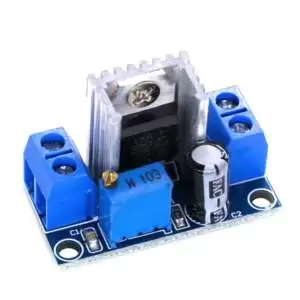Center Tapped Step Down Transformer 220V 12V-0-12V 2A
Center Tapped step down Transformer converts 220VAC to 12V-0-12V AC at 2A, ideal for dual power supplies, amplifiers, motor controllers, battery chargers.
180.00 EGP
Buy NowCenter Tapped Step Down Transformer 220V 12V-0-12V 2A
A Center Tapped Step Down Transformer 220V 12V-0-12V 2A is a dual 12VAC output with a center tap (0V), providing 12V-0-12V at 2A current capacity. It is commonly used in power supplies, rectifiers, and low-voltage AC applications. The center tap allows for both 12V and 24V rectified outputs, making it ideal for DC power circuits, amplifiers, and embedded systems.

Features:
- Dual Voltage Output where Provides 12VAC or 24VAC (by combining both 9V outputs) for flexible applications.
- Converts high-voltage AC (220V) to a lower, safer voltage (12VAC), ensuring reliable operation of electronic circuits.
- With a 2A current rating, it can power moderate-load applications like amplifiers, control circuits, and regulated power supplies.
- The center tap allows for better voltage regulation and balancing in circuits requiring both positive and negative DC rails.
- The transformer provides galvanic isolation between the primary (high-voltage side) and secondary (low-voltage side), enhancing safety by reducing the risk of electric shock.
- Used in audio amplifiers, industrial controls, battery chargers, and microcontroller-based circuits that require dual voltage rails.
Specifications:
- Transformer Type: Center Tapped Step Down
- Primary Voltage: 220VAC
- Frequency: 50Hz / 60Hz
- Secondary Voltage: 12V-0-12VAC
- Current Rating: 2A
- Power Rating(Approx.): 48VA
- Core Type: Laminated Iron Core
- Winding Material: Copper Wire
- Mounting Type: Chassis
- Insulation Resistance: High dielectric strength for safety
- Insulation Class: Class B (up to 130°C)
- Efficiency: 85% – 90%
Applications:
- Dual Polarity Power Supplies.
- Audio Amplifiers.
- Analog Electronics.
- Battery Chargers.
- DIY Electronics Projects.
- Microcontroller Systems.
- LED Drivers.
- Instrumentation Circuits.
Package Contents:
- 1 X Center Tapped Step Down Transformer 220V 12V-0-12V 2A








